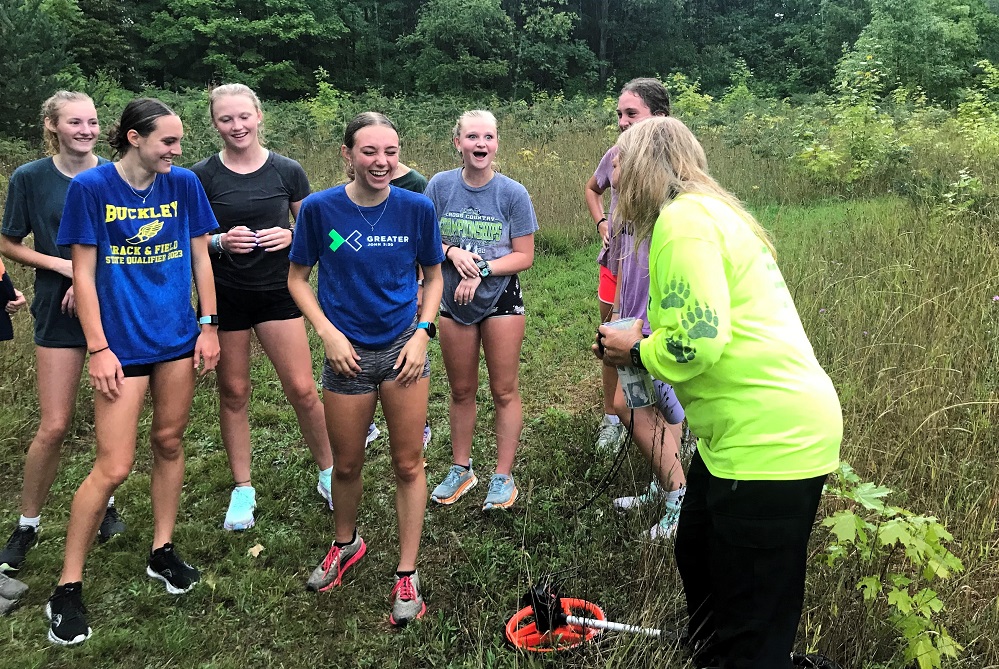
BEWARE of Bears: Finals Champ Harrand Pacing Buckley's Team Title Pursuit
By
Tom Spencer
Special for MHSAA.com
August 25, 2023
Over the years at Buckley, Aiden Harrand got pretty used to running alone.
 It is unknown how often she thought about encountering a bear. It is also uncertain how much she dreamed about running with Bears — the Buckley Bears.
It is unknown how often she thought about encountering a bear. It is also uncertain how much she dreamed about running with Bears — the Buckley Bears.
Harrand, now a senior, is surrounded by Bears – teammates. She had only one teammate as a freshman. There were no other girls on the team her sophomore year. Buckley fielded an entire team her junior year last fall, and the Bears placed eighth at the MHSAA Lower Peninsula Division 4 Final. Harrand won the individual championship that day to lead them to that best-ever girls cross country finish.
She also won the three LPD4 track individual distance championships last spring in helping the Buckley claim the first team Finals title in any sport in the school’s history.
Harrand is starting this fall campaign Saturday at the Benzie Invitational. They’ll hit the Benzie course with their two team themes in mind – “We’re on Fire” and “Watch out for Bears.” If the competition doesn’t heed the theme warning posted on their T-shirts, they likely note them in the results.
And with individual and team state championships on their mind, the Bears are also looking for another possible first. They have high hopes of picking up the school’s first Northwest Conference championship. The league has been dominated by Benzie Central and Kingsley, schools with rich cross country histories.
“Watch out for Bears” just may have been set with the conference in mind. The recent track and cross country success won’t allow the Bears and Harrand to sneak up on anybody, pointed out second-year coach Jolie King.
“We didn’t ever have a chance because we’re competing against Benzie and Kingsley,” admitted King, who also has coached track and cross country for Bay City Western, Traverse City St. Francis and Kingsley. “They draw from 300 kids, and we have 118.
“We have a chance this year,” she continued. “(But) Benzie is going to be tough. You know Mylie (Kelly) is going to be amazing.”
The Regional and Final is really where the Bears have their sights. Kelly – who finished eighth in LP Division 3 last fall as a junior – and Benzie, along with Kingsley, will compete in Division 3. The Bears will see other conference teams, Frankfort and Glen Lake, in the Division 4 Regional the Bears are hosting Oct. 28.
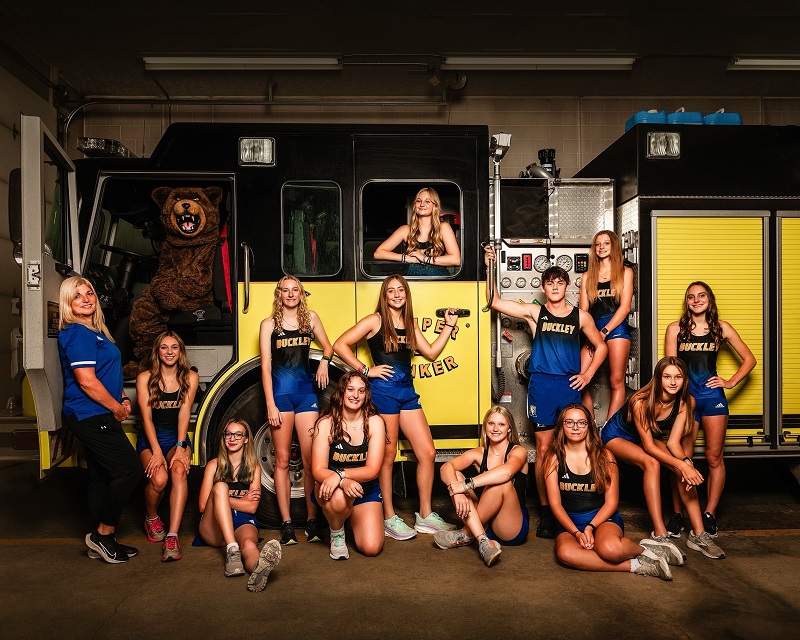 By then, Buckley hopes to be on fire as demonstrated by its preseason team picture taken on a fire truck. The training plans are set with the Regional and Final meets in mind.
By then, Buckley hopes to be on fire as demonstrated by its preseason team picture taken on a fire truck. The training plans are set with the Regional and Final meets in mind.
King said September’s plan is learning to run as team and focus on pacing as the Bears take on some pretty tough competition, including Hart and Traverse City St. Francis, two more top Division 3 teams in Northern Michigan. October will include speed work and seeing what the Bears are made of at the Portage Invitational, the coach revealed.
Harrand, the most decorated runner in Buckley’s history, has 11 teammates this fall. All the Bears are back from last year’s eighth-place finisher, plus they’ve added freshmen. They have been training all summer, meeting – and in many cases – exceeding King’s expectations.
Needless to say there is lots of excitement in Bear country. The season kicked off with a Glow Run, a team training experience commencing 12:01 AM on the first day MHSAA allowed practice for this season.
“I am giving myself goosebumps,” King noted as she talked about her 2023 team tapping its potential. “The girls have a goal to make the (Finals) podium this year.
“After (Harrand) winning the state title last spring, they know it is in their wheelhouse,” she continued. “They know they are capable of doing it.”
Harrand, of course, is expected to be the top runner again this fall. King is looking for sophomores Kayla Milarch, Brooklynn Frazee and Kinsey Peer to battle for the team’s 2-4 spots every meet. Addison Harrand, Aiden’s younger sister — also a sophomore— is projected to round out the team’s scoring regularly in the fifth spot.
Senior Natalie Halloway, junior Autumn Kelsey, sophomores Maddie Chilson and Allie Brimmer, along with incoming freshmen Kaylee Swanson and Mykayla Kulawiak, are also expected to figure in the Bears’ championship drive.
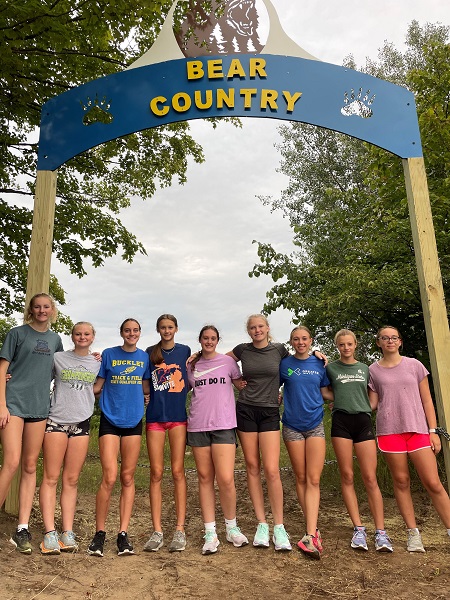 The Bears only boys team runner, sophomore Matthew Bentley, will train with the girls, giving the senior sensation the most cross country teammates she’s ever had.
The Bears only boys team runner, sophomore Matthew Bentley, will train with the girls, giving the senior sensation the most cross country teammates she’s ever had.
“I used to say I guess I’ll go run by myself,” Aiden Harrand recalled. “Now I have 11 others to go run with me – this is kind of awesome.”
Harrand is expected to be challenged at Michigan International Speedway this fall, and she will welcome the competition as she focuses on a bigger personal goal – leading the Bears to the team championship.
“I have my work cut out for me, but I want it so bad,” the senior said. “I want to continue this trend.
“I want to do it for my girls and my team,” she continued. “I am going to be putting my best foot forward.”
If she had to accept either an individual or team Finals championship, she knows which one she’d take.
“I want the team one,” she said. “I think it is a bigger deal to be a part of a team to accomplish so much than to just do it individually.”
Harrand is very special to her coach.
“Every coach deserves an Aiden Harrand on their team,” King said. “She is bubbly … she makes everybody come together as a team … she demonstrates hard work … she’s really been such a leader … she encourages everybody.”
Harrand took fifth in the Division 4 Final as a freshman and was the runner-up as a sophomore. Across her 11 victories last season, Harrand had an average margin of victory of 34.5 seconds. She took the Division 4 top spot by nearly 15 seconds after winning her Regional by 49 seconds.
Last spring she finished first in every track event she entered, with Finals, Regional and Northwest Conference championships in the 800, 1,600 and 3,200-meter runs.
Not surprisingly, Harrand owns an endless list of course and Buckley school track and cross country records.
But again, to her, team matters most.
“Her job for the team is to win meets,” King said. “But when she is done, she is on the line. She is coaching constantly. … She rubs off.”
And the sophomore Harrand really looks for her older sister to lead the team to success.
“It is really cool watching my sister do this and being able to support her at what she does,” Addisen pointed out. “Knowing she is going to be in the top five, and just having her do that goal and us follow, pushes us to be so much better as a team.”
 Tom Spencer is a longtime MHSAA-registered basketball and soccer official, and former softball and baseball official, and he also has coached in the northern Lower Peninsula area. He previously has written for the Saginaw News, Bay County Sports Page and Midland Daily News. He can be reached at [email protected] with story ideas for Manistee, Wexford, Missaukee, Roscommon, Ogemaw, Iosco, Alcona, Oscoda, Crawford, Kalkaska, Grand Traverse, Benzie, Leelanau, Antrim, Otsego, Montmorency, Alpena, Presque Isle, Cheboygan, Charlevoix and Emmet counties.
Tom Spencer is a longtime MHSAA-registered basketball and soccer official, and former softball and baseball official, and he also has coached in the northern Lower Peninsula area. He previously has written for the Saginaw News, Bay County Sports Page and Midland Daily News. He can be reached at [email protected] with story ideas for Manistee, Wexford, Missaukee, Roscommon, Ogemaw, Iosco, Alcona, Oscoda, Crawford, Kalkaska, Grand Traverse, Benzie, Leelanau, Antrim, Otsego, Montmorency, Alpena, Presque Isle, Cheboygan, Charlevoix and Emmet counties.
PHOTOS (Top) Buckley runners joke with coach Jolie King, far right, before a training run earlier this month. From left: Kinsey Peer, Brooklynn Frazee, Kayla Milarch, Aiden Harrand, and Addisen Harrand, with Allie Brimmer behind King. (Middle) The Bears’ team photo with a fire engine this fall is symbolic of the team’s “We’re on Fire” theme. From left: Coach Jolie King, Aiden Harrand, Natalie Halloway, Kinsey Peer (standing) Allie Brimmer (kneeling), Maddie Chilson (standing), Addisen Harrand (inside fire truck), Kayla Milarch (sitting), Matthew Bentley (standing) Autumn Kelsey (sitting), Kaylee Swanson (on truck), Mikayla Kulawiak (seated leaning forward) and Brooklynn Frazee (standing). (Below) The team takes a photo in front of a new course marker. From left: Kinsey Peer, Addisen Harrand, Brooklynn Frazee, Mikayla Kulawiak, Allie Brimmer, Kayla Milarch, Aiden Harrand, Kaylee Lown and Autumn Kelsey. Missing: Maddie Chilson, Natalie Halloway and Matthew Bentley. (Top photo by Tom Spencer. Fire engine photo by Amanda Patterson/Pattersnap. Course marker photo by Jolie King.)
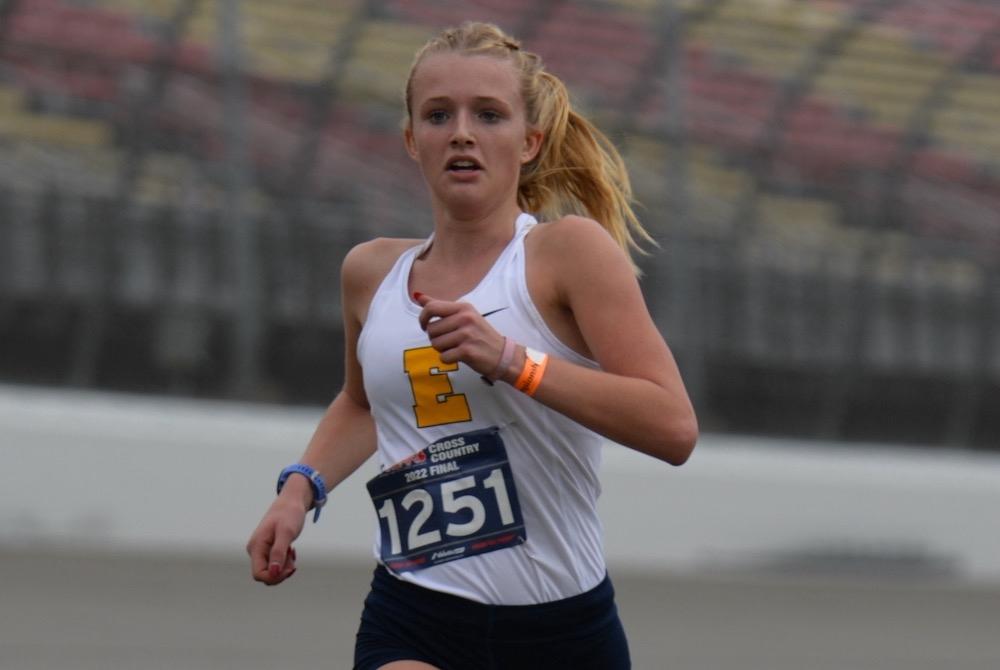
Past Races Pay Off for EGR's Muller, While Otsego Rises Again as Top Team
November 5, 2022
BROOKLYN – How strong of a cross country conference is the Ottawa-Kent Conference White?
So good that Drew Muller of East Grand Rapids didn’t even win the two conference jamborees she raced this season.
Yet, she was first when it mattered the most, winning the MHSAA Lower Peninsula Division 2 championship Saturday at Michigan International Speedway.
Muller crossed the finish line in 18:18.47 to win by 9.36 seconds over Otsego freshman Emma Hoffman.
The winner of all three O-K White jamborees was Grand Rapids Christian junior Natalie VanOtteren, who was fourth in 17:55.3. Six of the top 10 runners were from the Grand Rapids area.
“It’s been like this a lot during the season,” Muller said. “All the teams we race against in our conference are so stacked. Everyone who runs there is so amazing, so it makes it fun.
“It helps so much. Everyone we race against are such good friends. It makes it even more fun. It makes you love the sport even more.”
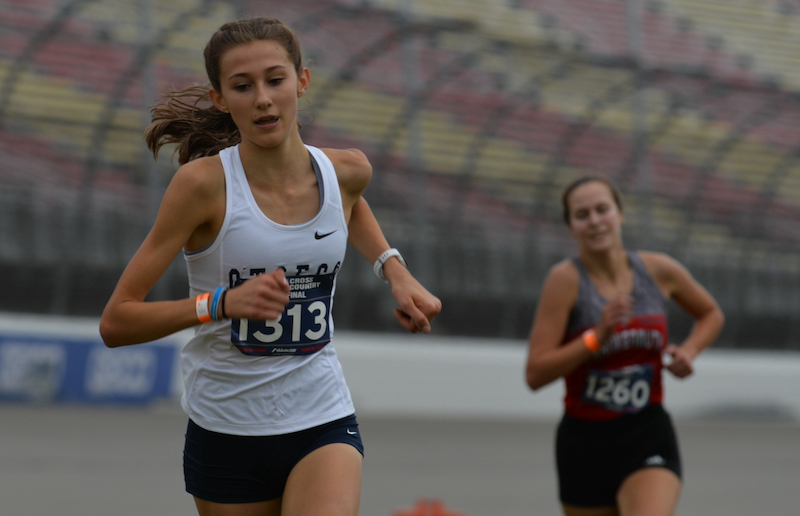 Muller ran with some familiar faces much of the race before making a break entering the track with one kilometer remaining.
Muller ran with some familiar faces much of the race before making a break entering the track with one kilometer remaining.
“I was feeling pretty fatigued, but I found my group I run with a lot and we stuck with it together and kind of powered through,” she said. “In the back stretch, I took a chance and went at the 1K, which I’ve been doing in a couple meets before this. It’s worked pretty well. I was pretty fatigued, but it’s good, good to be done.”
Muller’s first words with reporters after the race were, “That hurt a lot.”
Muller became an MHSAA champion after finishing fifth in Division 2 both of the last two years. She applied lessons learned from her first two trips around the MIS course to put it all together Saturday.
“My past races were pretty rough,” she said. “It was definitely a learning experience.
“Definitely in the past, I’ve gone out a little bit faster as we entered the stadium. I feel there’s so much energy, it’s kind of hard not to. A lot of people I race also go out really fast, so I try to go with them. That didn’t really help in the past. This year, I feel like I have more endurance to keep up and have a good kick.”
The only title that eluded Muller was the team championship, something East Grand Rapids captured last year and three of the last four seasons.
Instead, it was Otsego that returned to the top for the first time since winning back-to-back championships in 2015 and 2016.
The Bulldogs scored 87 points to beat East Grand Rapids by 11. Grand Rapids Christian was third with 153.
Otsego put four runners in the top 14. Hoffman was second in 18:27.83, junior Logan Brazee was seventh in 18:42.95, junior Megan Germain was eighth in 18:47.56 and sophomore Taylor Mitchell was 14th in 18:57.08. No. 5 runner Rebekah Stachura crossed in 86th place in 20:12.64 to complete the team score.
East Grand Rapids had three runners in the top 15, then got a 39th and a 55th from its other two scoring runners.
PHOTOS (Top) East Grand Rapids’ Drew Muller charges toward the finish line during the LPD2 Final. (Middle) Otsego’s Emma Hoffman, left, and Frankenmuth’s Mary Richmond follow Muller down the stretch to finish second and third, respectively. (Click for more from Dave McCauley/RunMichigan.com.)

